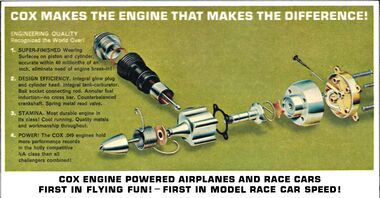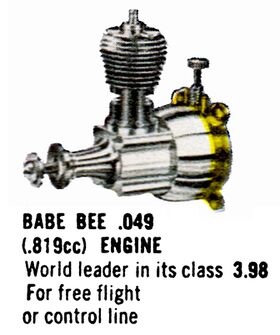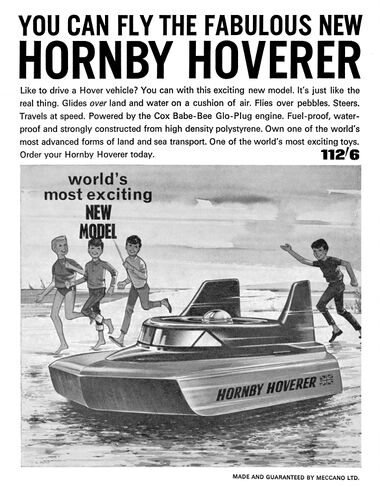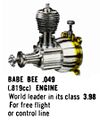Category:Cox engines
1965: "Cox Makes the Engine that Makes the Difference" [image info]
1965: Babe Bee .049 [image info]
1964: Hornby Hoverer hovercraft, powered by a Cox Babe-Bee Glo-Plug engine [image info]
Cox model engines started being produced in the 1940s, and quickly gained a reputation for affordability and reliability. Although the initial models were aimed at tethered car racing, the range became increasingly tailored towards for model aircraft.
Naming
The various Cox engines tended to be referred to by their engine capacity in cubic inches, without a leading zero (e.g., ".045"), and by a range of colourful model names either based on insects (thanks to the idea of things that fly and make loud buzzing noises) or letters ("Tee Dee" for "Thimbledrome").
Glo-Plug engines
Unlike petrol engines (which usually use a spark plug), or conventional diesel engines (which compress fuel vapour until the compression heat triggers an explosion), "glowplug" or "glo-plug" engines have a red-hot wire that triggers the combustion process once the fuel gas is of sufficient density to ignite.
The ignition wire is initially made red-hot by passing an electric current through it – once the engine has started, the wire is reheated by each subsequent explosion, and stays hot for long enough to trigger the next cycle.
Glo-plug engines are particularly well suited for model aircraft and other fast lightweight powered models because of their combination of simplicity and low weight: they don't need to achieve the compression ratios of a "proper" diesel engine, they don't need the complicated sparkplug timing mechanism of a petrol engine, and while they do typically need a battery to be briefly connected to the terminals of the wire to get the engine started, the battery needn't be built into the model, and can be an external battery that's only connected for the time needed to get the engine going.
For some model aircraft competitions, where refuelling speed was part of the competition, owners sometimes made special pairs of gloves, with the refuelling line attached to one glove, and a pair of flying leads from a battery ending in terminals on two fingers of the other glove. The owner could then rapidly refuel with one hand, and then "zap" the engine into action with the other.
1965 advertising text:
COX MAKES THE ENGINE THAT MAKES THE DIFFERENCE!
ENGINEERING QUALITY Recognised the World Over!
- SUPER-FINISHED. Wearing Surfaces on piston and cylinder, accurate to within 40 millionths of an inch, eliminate need of engine break-in!
- DESIGN EFFICIENCY. Integral glow plug and cylinder head. Integral tank-carburetor. Ball socket connecting rod. Annular fuel induction – no cross bar. Counterbalanced crankshaft. Spring metal reed valve.
- STAMINA. Most durable engine in its class! Cool running. Quality metals and workmanship throughout.
- POWER! The COX .49 engines hold more performance records in the hotly competitive ½A class than all challengers combined!
COX ENGINE POWERED AIRPLANES AND RACE CARS: FIRST IN FLYING FUN! – FIRST IN MODEL RACE CAR SPEED!
— , Cox, , Boys' World, , November 1965
Some early Cox engines, 1940s-1960s
1949
- .045 O Forty Five Power Pak. Thos was Cox' first engine, but still had some major parts made by outside manufacturers.
- .060ci O Sixty Power Pak. Slightly wider cylinder version, to develop more power for the ThimbleDrome Special racer.
1950-1951
- 0.049 "Space Bug" contest engine development and release. Full production in 1952. Designed for control-line model aircraft.
1953
- Thermal Hopper – a Space bug without the fuel tank, for tethered or free flight aircraft
- Space Bug Jr. – a cheaper version of the Space Bug, with a plastic tank.
1955
- Strato Bug – Space bug with a cheaper version of the metal tank.
1956: Bill Setzer
- Babe Bee .049 - Designed by Bill Selzer, this engine's body was an aluminium extrusion rather than a casting, making the engine significantly cheaper to produce. The Babe Bee's low retail price, combined with its reliability and easy starting characteristics, made it a default buy.
- The success of the Babe Bee caused some other small US engine makers to reconsider whether it was worth staying in the business, and the disappearance of some of these other brands further increased the visibility of the Cox name.
- RR1 – Tried to achieve more power by using a "rear rotary" valve intake.
1957
- Pee Wee .020 – a miniature, half-size version of the Babe Bee.
1958
- Golden Bee – a Babe Bee with a special larger tank for stunt flying, that allows longer flights and also flying upside down. Anodised gold colour.
1959
- Space Hopper - higher performance, without a fuel tank.
1960 Bill Atwood
- Atwood (already responsible for a range of engines) is hired to produce a 0.010 engine, and also produces the "ThimbleDrome" ("TD" or "TeeDee") and Medallion engines.
1961
- Tee Dee .049 . TD (for "ThimbleDrome") engines had an improved piston design along with a range of other improvements for better fuel intake and better balance.
- Tee Dee .051 – premium version, with a fractionally wider bore, but the same output power.
- Tee Dee .010, .020, .09, .15 – half the size of the Pee Wee.
- Medallion .049, .09, .15 – a more budget engine than the Tee Dees
1966
- QZ ("Quiet Zone") – a Babe Bee with a sound muffler and multiple modifications designed to boost power, to compensate for the power loss due to the muffler.
External links
- Cox International (coxengines.ca)
- Cox Engine Forum (coxengineforum.com)
- Cox engine of the Month: pictures (coxengineforum.com)
- Cox engines (mh-aerotools.de)
- Cox Engine Collection (sites.google.com/site/coxenginecollection)
- IC Engines / Cox engines (modelflying.co.uk)
- "How to get the best performance from your model engine" (mh-aerotools.de) – pdf
Subcategories
This category has the following 2 subcategories, out of 2 total.
C
- Cox control line aircraft (1 P, 15 F)
- Cox engined cars (9 F)
Media in category ‘Cox engines’
The following 3 files are in this category, out of 3 total.
- Babe Bee point049 engine, Cox (BoysLife 1965-08).jpg 896 × 1,071; 107 KB
- Cox Makes the Engine that Makes the Difference (BoysLife 1965-11).jpg 3,000 × 1,560; 1.24 MB
- Hornby Hoverer hovercraft (MM 1964-09).jpg 2,341 × 3,000; 1.02 MB








